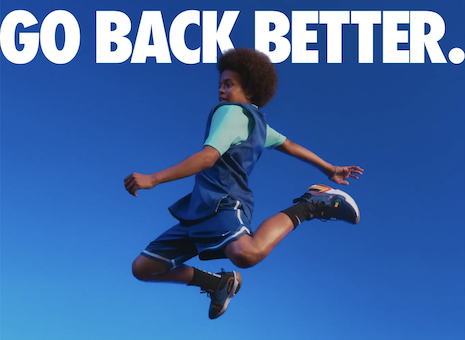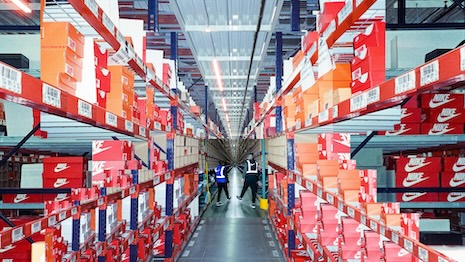By Jason Haworth
Sportswear giant Nike last month reported a 28 percent loss in net income from 2023-24. But while profits are on the decline, bots are on the rise.
Nike admits its SNKRS app – designed to level the playing field with ballots for coveted sneaker drops – sees 10-50 percent of sneaker raffle entries made by bots.
Let us unpack that.
Nike has a market cap of around $110 billion and has forged a seemingly indestructible reputation for itself over the past 60 years. But even Nike – arguably the biggest player in a burgeoning industry set to be worth over $128 billion by 2030 – is seeing the impact of a growing bot takeover on customer loyalty and, in turn, income.
So, what about smaller retailers and manufacturers that do not have the luxury of a bulletproof reputation to fall back on?
Dead Internet theory
With sneaker drops being highly coveted and selling out in mere seconds, sneaker raffles were designed to level the playing field for customers, ensuring everyone has a fair shot at winning the newest products.
The reality, though, is raffles are now overrun by bots often operated by professionals who make a living from reselling sneakers for massive profit.
A quick Google search reveals hoards of videos and articles educating people about how to use bots to capitalize on raffles.
Meanwhile, technologies such as AI have made it easy for budding resellers to create their own bots at home with limited technological proficiency.
It is easier than ever to become a professional scalper, with the sneaker resale industry set to be worth $30 billion by 2030.
In recent years, the ‘Dead Internet’ theory has been picking up traction, with some claiming that the Internet is now made up predominantly of bots and non-human traffic. It might sound like an absurd conspiracy, but recent research in 2023 found that 49.6 percent of all Web traffic was bot-generated.
Nike’s bot problem is a perfect example of the ‘Dead Internet’ in action. But far from being harmless, the scale of bot activity today presents a real threat to businesses and consumers alike.
Nike and similar brands will continue to lose real customers, while consumers will see themselves become second-class citizens to bots – who will inevitably always have the advantage when it comes to buying rare or coveted products online.
Price gouging from resellers might see some products become exclusive, accessible only to wealthy customers, while loyal customers are marginalized.
Brands such as Nike have a hefty bank balance and large fanbase to fall back on. But for small and midsized retailers working to build brand credibility and loyal repeat customers, it is a very different story.
 Nike Go Back Better. Image: Nike
Nike Go Back Better. Image: Nike
What bots mean for smaller brands
An online presence is no longer optional for smaller brands – it is now essential. But in the age of the ‘Dead Internet,’ many smaller brands and retailers hoping to reach a larger customer base will be disappointed to see that a large proportion of visitors to their website are not legitimate human visitors – they are bots.
For smaller retailers, these bots are unlikely to be the scalper bots we see snapping up limited-edition sneakers or tickets to see popular music artists.
Instead, they might be web scraper bots that trawl websites to collect data, search engine crawlers or spiders that index Web pages for search engines, or click fraud bots, artificially driving up click traffic to generate revenue, among other types.
Some of these bots have a positive impact for a website owner.
For instance, search crawlers can help drive organic traffic to websites by increasing visibility on search engines. But the majority are bad news for smaller retailers.
Crucially, even ‘neutral’ bots drive up Web management costs for website owners, as higher-traffic websites are more expensive to run.
If smaller brands and retailers are receiving high volumes of traffic from genuine human customers, they are likely to offset this cost by making sales. But if the traffic is mostly generated by neutral or negative bots – actors that will not make any purchases – these retailers will not see any return on the cost.
 Jason Haworth
Jason Haworth
Learnings from Nike
Nike can afford to sacrifice real human traffic to bots – and might even enjoy the exclusivity that bot-driven demand has created, even if it is harming the brand’s profits.
However, small to midsized retailers cannot afford the same luxury, and are unlikely to see any sales come through bots, instead being hit with inflated Web management costs from neutral and negative bot traffic.
Importantly, there are ways to control bot traffic and there is sophisticated technology available to smaller retailers and brands.
Fledgling retail brands should learn one lesson from Nike’s falling profits: bots spell trouble for businesses’ bottom lines.
Jason Haworth is chief product officer of BotGuard, Everett, Washington.
{"ct":"zK4J9AQdho5dbaIPxurr55qEUVlvzb5JkOFzVWMgyW0Yo+GcbvNh1bP5Li4ldMVU12skxdAgTi+lB9Un+k7bPD9qHTzXLB8\/NmLOYgtedk86opYXc3jgWQGpT9xrp2VuOdUS8sXeKCQpfSlkwBes5XQDCmFLuTkqhLCP2KDyq4QFLGUt0OkUya9nKqMmd0nCwGjeAxJDOT9ncbIVWeOSccT3fcAms1EVhqgEad1nBxuz0fo3oiBtdLWfFGCdBDK1dTMLi2Qlt73W8YanHfQ7Aphw0qUx90vx42lnS4s\/gGFHXyCanHQU4OOkQHc1NALv3EuQ8W90RyfUjzrDF1SOnzBXZZpj+WLyxWX+88gN8rl6C8dKP6TeeMulIfd5hPdOyL0kf7xCM7YJBoHwi5cMiu3wPRMrTueGBHqW5bre6nBKFEHxPGyUVZqZQl1xJoWU3t+Cnd7K6LKQZzfOjpKfKSaBiF5t7\/b7w2t1qDlSDIAXIF1ifWR0J\/bzhqChFNR8UmblsIGIPKY8ocfpJneuqyJk4ujmADzVD2XoyimBImI5xy8WKOEt08SHDkbKs7A5m4lavwG3bZ5Y+yLBrYWj5n1s9auxMC04KEX2QMZCX\/DaIP12lQYTNHTiCc6lyxBMO5VJ7\/c0b5XuFMuJrSqEqenUFZGKC5n5IseNIsRQo50p\/A02oAnD1KasqaBW1DbPfENlhWF3d41Kwgd6MYnV9BCDQEIDoM680n2cq75HiM3G+sEGEO4OzbpY2QM7RccjcyvD5HrViQHa2zzzMOUyrZryliYpheRW3iaaxSLjKrpm6nlLBM1D7bqjGxKE05jcTTpch4o1mV+zP1lE3OafyXLtF7O6asj8PBAKlwMtoI1Cpsm\/yBnrSxak\/5wX6cYgYrkLAQ2nkPHLYQmRQXpxRqXgfW9spz4DaD1ZsPb0S61vJW08s3XqdA2Hq9PauebsSjPfN4kCGUsUrPSFSwgVTQR7CeEIHtCRjnrC9sGk4HeUxMCJnfq4vloofEpBXBkWM3Mx0sy9mqyq9CcsCsyyYKkiWxnfruXuUY9qCgVkw9SlEVorpGDI6ut1DA2y0RfCVBabOsvjZxXf9g56DN3c1XgfB1n+8mk\/qk9rsCBjprZ4k2JJY+qIZbG7bCZoMf7GdNkwVKZ4\/uV1X\/TDXJFqKbS+G\/9dLL18pN+6uEHxN8RilMp6pINcrGJ\/ZKmVpGRiL262XMLH\/ZpC\/uKMfkJbFOOlIoMT47P04yAZxX09rXI5S\/boVpSRPVyqwtwTKm3n0zZtAB+U0bW7r9LNjVw+EJxh1o+W3WvUxKHYuFxAv9Js5CDxRtAtxmWGu4aOKEbu8vVhamWPZDYF81UJ90ib2FyAIM+221LlEQbR3bSateoDtleApy4gHy+dRaEqg5Akb5y93dAsCAIjZFs1xSMNXpIgXlvppKd3almIkii+kdvGbzAJUckRGK92ml5R77+MT0dvVXeUZ6Upy4\/uOXKERt892qMjj3m\/D9+s1mEx\/09bvWhV8ijkLOkIn1\/NDhd+nP48PMVbsqA+pGNX5jyLhCgHKifEHLfe7YCObCqHGFFHbcP\/xdGXiY0d8+GvDkQ2hExEr2nrbgi4blc9kXtouREA1jlqd9dIf2fZ9QKusMR60bEOgWbBudCSkg2Wf8CBDq37lZLvuMdvgX6rkAUdrXe37a2XdLo9DRrIe4Oan3+PhHs++5K0XoJz3T0fikYxnqtNtyjKktHZ6AxNGK8ci4UqRaHUQ+ESq37wko9QnUvmCJP\/WoLMeS2khkh5vBE7ReSPCROd5nEBP4SHK4LJ\/qXazDHYPa3oUpI2qqdceJe\/y6OQSyw8zimljODlI67aayYCvR6WlFMDVymYebI14\/ufamaPJDiIJvLnxp5hUJqG6EOtooKViSEZpkirF01U9CuC7cxY9ekFfzAI9HayZtXKyxWL5EXbHC+LO5fU9F822q3HT1Te9XR1t2xEVB1HfJQEskqQKmkqFeS303r2jzaQUPlMzpibZ2qCb9TfExDUd4cjwMHTkr7s2vQsQYY8V79Q6Vhff90dZWSNMjJlj1syVj46r0xywbjHJSUJ\/fJgJOTBiTDYZNwES2jTvi0J4bfudglAMLBDINnylLnIuqwNxIwaPlbXjl8k5FK2JEJwK8J6pIZRuQY2rrLWWKI6fm2KGOVmxyAQS52aGrpLgSOV2woZ23vJeQfBO3kHDjn0TbjZgVF8lw6iYKMhHCk+Uwb1iXZWsHh6h7taV9Z2IBOuXC\/tas6WsmA\/CrLzfeKvwjspQZtZSVfoHBIG3Ej0VVKW+uxQIrjMevuyaSPzcmbD8OF7w2GYPQOf+X1VQD+xhq8bvE3hkMGTeumSlGKycmjT\/\/9PANMHuAFyFds0\/2xhM1KJV2SoXhOhxpM7BdF0RsoPw8Hqgq4zeR6uUlqDP2PSZh72hdzzsc3QRBadgZQavaGqqkNKTkneUgvBlE8A6uPf\/qbUnxQCuYsPSqfk\/Ffu+sVj0tmV3q7TRkuNDx8GJFw5hQjMC2xMq7q8eIJaN26oumpY0o+d5w4brOjM7wMVrcJ6JgmVEqkORJ+xKqGzAotUjkErbwCVK6Oizdap\/vs8xIPvL4SPdiuM9sjpHJMPQazX+EL8e6rprqQmjkPXK53Yj60d38KfqgRTVCFhJo3e2C9cODQywQRMYg74e6ceZEBgoc0XKItuVRVTs2+fmAeLqP9+qhB2LcmIfboHBuVpcyEPP\/FC+ZKbCZLICGOlK\/qadGVbMzjIEkWsSNII5EGbBvDIlbBIBqfT+NZDSpumBC\/AnE7fjen+m8W0FWAnk3gYRXavwDEzbCu4hOVkAn97eWisUHCYe+uDt6yBoundwAyrlnz993mdd87etPEUTy7u3uZz07hOFxbWy\/xtwOC9gX8dunGcUz29SFwN+CVMqAad3Lh0JAIkaOLrBvdtlNfFJ6\/HvpBNeyVogZLcqPD2bx1IaXQYSv+biRch6q6cauWPpsYbzvqcvHe+vgduU7rPEiXBg8opPQFNWRG9gDUrPML\/hluLgC1nmmWAXOOIvQ+xe4FHsIIELW6uL4Dx96dmTHBtopilSnWdA5Ayc9UHZ8gJzlJV9\/oCRNLt79mizH3p48EQ2JlkA8oh1hy3dcJ5YM0QwyvmTpxBwxWEGK708CCtTsc8jyvUEfT3zaRr\/J0mVz9R9JopKE\/hGwqeXydssVbFlQVfg1KFKZGFgo79BT+Vmu8Q8a+UHWjsDrZhNj0CiLSaWPp55IKY+0Pv5qon1pnODhgpCqGqcY2Qn7bWr278HvCqqXpkUs\/NBzMUZXwFCCEovuWc91QF\/YzvZbECTBUNBXFW7R\/xNFkJ\/dUkibBrycAhSkPlq6ZuZddnkR1gqfmP3I+7JKOtTLwR7hJfE0NjgLXfnkkrW7\/q9Jxqa91AZiM4leWdmibipDJZgLiq9Cb10EhbhYERVixvqK5o3m9+yckDsTk\/6uW8dPp0U66vskAW4AZx1dipsgT2ss+FxrYK7B6HodkWW4hFk9yoF9naLZOwANevbBvC0EWmKPAGO4tVr7rHvFXtWgbBW8tYz+3zZ8PGuGjoDQbwo\/uE85ZH7XIHu32Ca1mARiqQh7\/rsh+sQ5FMirG59xdLeUPzwpwi+U9udnNkv4fHDSvJT2xt4WtL7wAns19DKpeH2dHzA\/HPcaYrnO6\/I3yN4PkBmkTu4yYBOL7dTzpA9\/tc4KjfDOYTKx+05GDmkbwFs1xx33ZwFeEK6SLqyl3Y6whx7Ax1i7AA3uWFTcNx4fa6ESVnVsu2OWhYpAcQ9J907A\/bYnfj7A8kRdhSpmJCmAj8CN2XFSEhTsioKR9uSgH3\/rse26HvvWwFTktVqwFt+TP8tmc7bCxMIFF6AT4SyyQbefsmBBTJk9hHV5mfOBixexxlHHCl9PD53E1bmidV9vulDsomURiYcvQpcYVfSK8wEsje2235HpaTxt4wLnrjAlkB3PQJWf2kM2xRYfHJUVUnoKoqjaZb3Ymur8\/9wt3\/d+X3d4igeqvnvy3Svymzw2yEvFFbxURYktZiP\/VqFYEQ\/liTTh8WItBAAa2CiteKbwYoofs4+DxwYIdjtAgZ7emym5n9t1re9iHlKeJ+Jgp5a2k6ZjR8rLUItUpv5rdG1MCdqZS\/4k85b1jR93Z\/giUMKDUrttHC44TBtNl1p1XcQKjW4KK7HOYoeA2adrkOuLBLroedgwp2NOrwOSB+6n3M1bulumWNtdW+x35AFUrkAqXbZMIqBUUN0XxBcCJM1xB7+KCIbCe89oEjIEFWCf22XxRALMUARYJ0AVv\/dNYT2xsjmfbtuz8vGQCIulNHwoldey3CAtKBX4705CC8\/P9cgd5WJS0v6oLAanGh2JUrgi4la2I5Wb3VkRVItmzmg1KDgXZow1CCTiHL6FilUspH9kB3WNSckj8SBTuVhUx\/PAt9Ut5iVu6I3daZ9GIGUDBT2MAToR+J8R1C64pArbS8bPClkixrrcuOhZldLOZl6wtCyfeLlfyAu0Z6G7iJvO7dNUBiUXFmW02xTN9QoktEhUDByGS467uBmlCJIniFfKjhuHyQVeOudVLcIDWdz+FxzZlX\/8VVMyep\/InIye1rjb0XjDluPH68FRv1Csul6nWf7+Vh9krZ3G1LcflV661y5J2mPBe3NzGbzgIkCkNItt3VgEUkV2Sc8zVT\/b9fSNDcq2KINP3VATfE1fLIG0B34XzkUZXpUqr+rGKao4ubhG23sc1XjTGIrLNs9HL+R\/c84c\/stgnK579F1YcAY2x9pccBlrVygFDsvkRol1ZYpq4QD0IYzhdjiopaPYfFGVBouJiqMxUJYq5ztAu2lQaLawDGsMcAoIBDEiEQ5pmTijWkh6ramEsYwxgkHy6WEIPJp8+UtvrgFfKXAKjHIRxGll3EOgU1oJxBmYQUPXVezj7cdy\/HlV59J01BLTI6rgzfw8IlP8qDO5TSAABxAiVL4anPf3J1F\/yWE4HrfopmHDIU1T\/AV8Xa+Z6dhBYznaCl2fb8zUjy4midcIgydotQ77q2a6AJX\/i4zyera8\/3AUQJ7fpnAX9A4PiJjbLYUPL2UkbUNkh8zlllfVxJdQCZvC9j7LoS4qCCd2aOrCJ9ptLytGkoG6Gtr0Rw4UdoEtoVEdGplEFjhollhKAacb700V8vhq532dphXEtyvFlRcI4jOxlN0g8SGkg33AwrVsKZK8ZkBbwo0kIPBOQJ\/l4MjAM\/l6eajvBmZyJRShBiun1wGdLFcBC5GExw7JhzUxvuKCcT2WA7rYQie5X9\/hsGMcP4XfhK1yuZrFbWvCkp2l1RP+5sEyPEUWDDvbnuFXfRW1sd+3XuMENU3G\/YaI8KOgqU8o7s1AL\/gCqb3gyFq71O\/pZ9M\/li829HpcupCbiOeD2oA3FvARGTfz5CmHtXet85UiDMP5Q0dDR8iZiIEEJDdTrlbaHuKGP\/feLFXRhqiIcnH\/CtY2hmf\/k6WMOxr1narwyUp1PPXITK8on7+mCybif1NOffYAeEGz8+CyBBrQbNvPTEtanpCG4YEC50PshL\/EJpIGkaBj5or4gw9MhRQtKonUlIyQ5Ct9VGX3HvRiT+7EjYRc13PfjBhjVXMjwRL\/STvREF2UL0ztMVjqBYAbG9IV4dFhAGgF6enLuDK0CcsssYN1LIr3OQCQ5SKEEaRs0U00Fqumoldt0YFKw343YAQxl5UUw2bT7Td5lWbDPmzPIMckil4q+vyy7kVJr8pY1EHZSTsAvY889SxPUguogP+HJcvs4MRacrrvCSwvmui5GR8JgEfaAMYKyRNL7TzaFUPOesM1uFdxDMlDAJxcCi2mo\/kkisWJukrr5+DOYWqajNervTxfCanpkDiR3r38yU+HqbGrSnxHvCvtm57gbxX0rGdOrM4R8FZS9IrDmjb4SsAbmlQLwKBpReT3dEgf8iIa+gIgQ3OcaxvrLUMO+ltlGFbG0HBkB1IFRpTSZokAoPG977sMB45e3c8EhHncE1kEciyuMddKYjfCuMv+ADJFnD+qsVG2vCy0nvsyDNZXbToTlVH+Tkie8lO1xuS7VANVaH2OBArNwYQ6v1pQ8PVU1Wsxzh9Z3T3kPEZvrJvBR2ykavhQrQmRFitmTiSNgZUCscuWTEtwnpLjQw2H\/9ZB+v7E+ssDxEwU4xTm\/nfkJALlCvd+SKZxP4rf9Y4D8oL3tkGLUtAeT8W7O+OYTFApfwtU0eYw01\/VgjHGGg13qtphWx4CTwBj35HMntukz8vEZaa8yE8PUfGWCLVBdDCSthtpeFLch9Xf8Isp6O9Pos5X+MEWFyM6SMlpORujAt0EX5qenk4rkjgWYApnXGIhPRKxWHzS5hO5jEmXqKLtUqeMpVtTHQHKRgm4WC0vuCsxvAhV6S2aBc5S\/pqyQ9gIdjvrgQY9BBazAcQ\/peDKszEAaimbPuM9y3xXX3iM2S8X4v7FDbqm85J+2agWlGRvg+ZHQGzuE4noWAdHp\/bX0muc0gGIULEOfgbigAWX61YJsRR7u2ES73oBKDP9mxXdURBKbs\/vkpY7Q6zXsTQ2wu0CjD1aF32Nbtak6P67RMW8ITxibXbZjJj5WUx9rqjcCTEPp4\/vx2sMpvCPrQPtih6o5UeDi2BcOANbGrfYLun2k2\/N8dZ\/aaTIInrCFOrrZg\/k5KMeG7RczjSxnBNJZtuCZ3\/ha\/3T\/0Y8s\/mNPPaBOdh2N3txjr6ZvR9D46UvKZvFNJXUx6NMaG4e9w2rtQSS\/djlmILx74xMlZ3rDhP14aYbvcwNeCAojdbQiF2ho1jwVxkZGZmW2rrPPjbF\/7IQuPaC9pvzSPWFBSqtWBitvzV\/ku+HxQPrODACza8EfmqGDb3L5vyBZjWeSj+kD1rYl0UvmSHdbFY61XB1n3L8yXDtMuFcTRKiLYvsPTElxs5C5OnuzbDdF1fORlxCrbDr7zPly3ndJ3naq4a8dvsn2uI99tdrHM4WcLT3z7bxGSAN9yUZJkovuKIXIrRmmjfV5joQJLu9Scw3VpsY\/3F8BLl5wQeWVZFXvTN3tABMFVY6umnTo9qgRUJREBGlfqvi\/B8uhyW0rR1VAuXcag2HrRnhzcAG7BucYs7yHC3zcR4t3O+LswcXZ6GU+DpE0OqIWDidVzsRL\/EJAp8zeLDZ\/fd2c6qUl1fKPh+MuYSbpkIjkH2m5f9brVjko6w+S36iENSMSTu0x0NDIR2g9+lvuXWuxmwRyIDSiLq+2vV0S4g9bSmoXbzh0\/WHtYhvo8x2Q93bC988vVIGARuCi0acFI0QCL4pOcgV8ehyK6gyaatRZn7cruZz7lM+1g7w7cDnHL3OMb+QT25zEgJ7Y\/kWurWft2Wx8S73qXd18njduBW\/ldKpPZ6XIYtwZTn6fIc9H64+8Nv6EfskxHylIDj5qHGziqiskIyqwI4T5QdviBXIqlWPUYutVagLtLTTvbLUA5YpAt4Pf5deuerZN6qHByuSsHKeu5BJCJE5IKsc5fh\/ivaQPpcEx54C1dw92Lu9mj0EBHvb5Zfk9iQogGK7aYHDcFLDpwit\/5ftd1PCUA8IbhOSDo52Xs3ETqUpmYaFLZBIdgExQjUgAAfq2XunFMMGz\/QwxDHLa1fSExSLu9Djx7MZfgS9Ipd53rEqzjItizD1jlTiW1Tg4yeBpY2qDwvutSvgb271pWyFZKqi2bDOcNNd50doqsm4CzuqIh\/ruE1W9zij\/8\/jEj59dexGQhrHVdEll1e8FSj4ePEWGvAkV62Y+gNGgnXckFw\/Vgdi5ybuhfutL3QB6wLZZ8Uj1S8H4HTs7j91fEfupInUuqM\/MGcTPEOng8iYu6KmXcaeRnCO7RSJczyXSheqKyu\/965dXD3s3f5eB5yx5lBTi\/gGu4Q5q7inoXL8XnBoLi2Gy+pY5ZnMnXYjJ5B7L\/rBlC1FY20J0vTn7QUZ\/t4vl\/MRD1wSuyTdfLJ7L84u\/BWcsp8RqYxdbpWOEzazjsPJ2qRi7UPbOX\/r7FIwdQ4fFp\/75Xr2qgB6PIsAf4LuGVwem+o5l1CKo2RoAdEmTxbqrBJFE3aNLuLbacdob2Jqmq0EILdolH96x\/khWA1oUY6U3OHbJFUNMQrgrJ51cVDfACdSoVDjTlPpjzI4tJ858lhcxR9lGCZKnTNXsfiuXTrvJMU5MDWLOyaA4k74vlaUH0pqko+H4Y+ZTgXny4qnk5dxCAB0iJstK3xxkjfbkHxI318H+1JATWz80z6iJKVaL5xaCP\/dTtPO3LBJoEpOafBugBtwFsvEFoCPo8UcWg2opjJ9H2ey+kj4\/DZdkWRz132cPB\/G5UI\/VwnUmku1E15PysscFqkORlFYKJQ018nfSNpTFNrATnSF4g+BkXqX874IYEgIocYTIK\/BjijlYUEwFauWp\/3fe+fhGUf2Zh04M6O+fwThv86Dp3\/TrsPowAmoZVsLn4nMeu285m8BSCwdaIlZ+gsCFKyD6Fi90mFq+WdM7n2pIfL4sUtc\/m7v95jdlDgaJXeRd47iPmHbyhdVqCvyDUJ300Ntc+PSM=","iv":"5819fe0b701ba6323c8334bca9e56853","s":"3abe848ce6f05106"}

 For millions of returned pairs of Nike footwear, all roads lead to Nike Rebound, a sprawling reverse logistics facility in Lebanon, Indiana. Image: Nike
For millions of returned pairs of Nike footwear, all roads lead to Nike Rebound, a sprawling reverse logistics facility in Lebanon, Indiana. Image: Nike
 Nike Go Back Better. Image: Nike
Nike Go Back Better. Image: Nike Jason Haworth
Jason Haworth